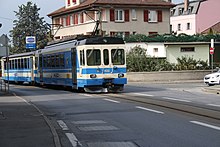This article needs additional citations for verification. (July 2015) |

The interurban (or radial railway in Canada) is a type of electric railway, with tram-like electric self-propelled railcars which run within and between cities or towns.[1] The term "interurban" is usually used in North America, with other terms used outside it. They were very prevalent in many parts of the world before the Second World War and were used primarily for passenger travel between cities and their surrounding suburban and rural communities. Interurban as a term encompassed the companies, their infrastructure, their cars that ran on the rails, and their service. In the United States, the early 1900s interurban was a valuable economic institution, when most roads between towns, many town streets were unpaved, and transportation and haulage was by horse-drawn carriages and carts.
The interurban provided reliable transportation, particularly in winter weather, between towns and countryside. In 1915, 15,500 miles (24,900 km) of interurban railways were operating in the United States and, for a few years, interurban railways, including the numerous manufacturers of cars and equipment, were the fifth-largest industry in the country. But due to preference given to automobiles, by 1930, most interurbans in North America had stopped operating. A few survived into the 1950s.


Outside of the US, other countries built large networks of high-speed electric tramways that survive today. Notable systems exist in the Low Countries, Poland and Japan, where populations are densely packed around large conurbations such as the Randstad, Upper Silesia, Greater Tokyo Area and Keihanshin. Switzerland, particularly, has a large network of mountain narrow-gauge interurban lines.
In addition, since the early 21st century many tram-train lines are being built, especially in France and Germany but also elsewhere in the world. These can be regarded as interurbans since they run on the streets, like trams, when in cities, while out of them they either share existing railway lines or use lines that were abandoned by the railway companies.

- ^ "Before Interstates, America Got Around on Interurbans". Bloomberg. 6 October 2021. Retrieved 3 March 2023.